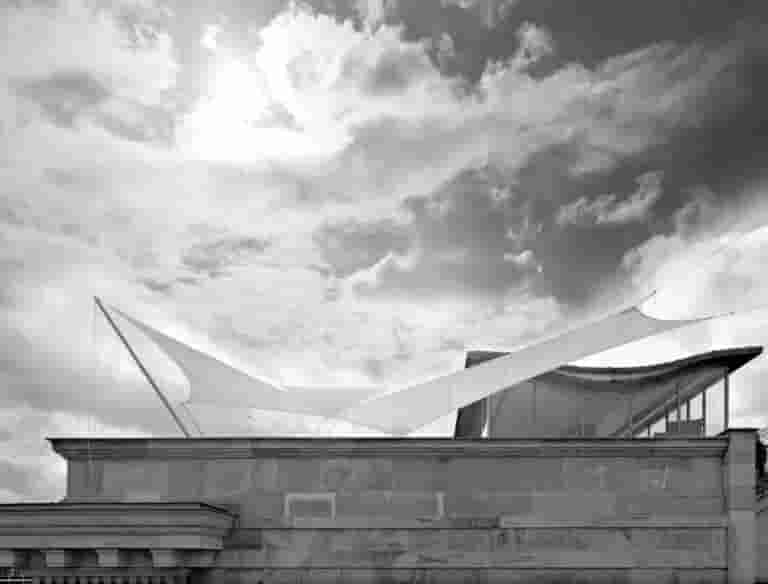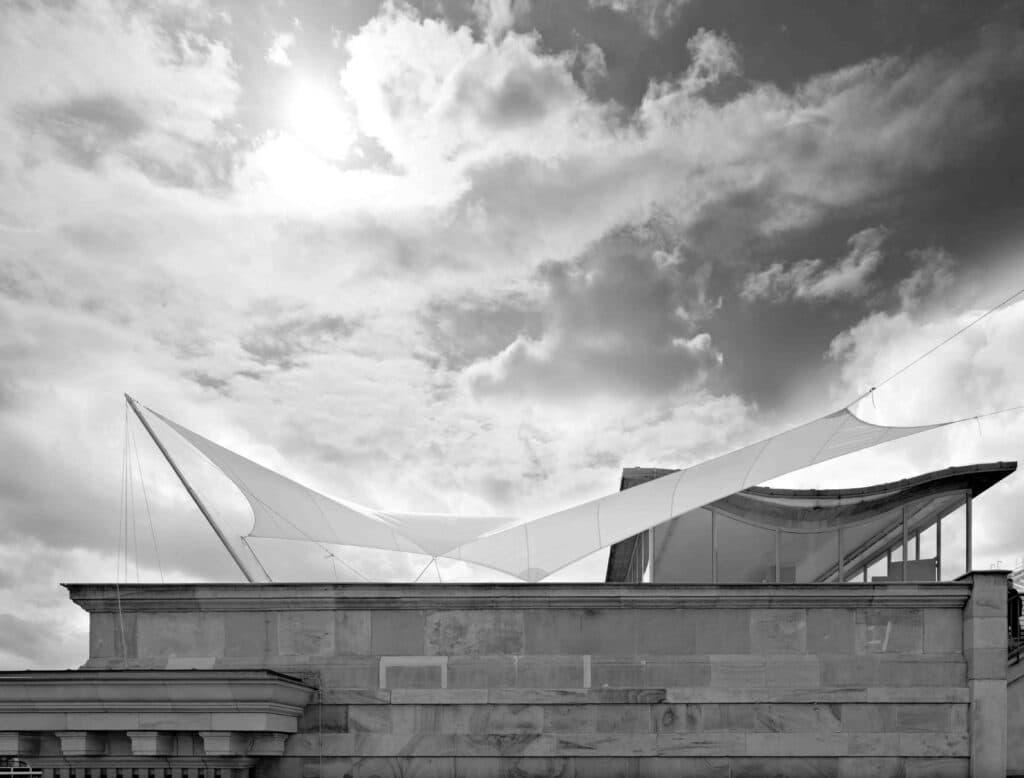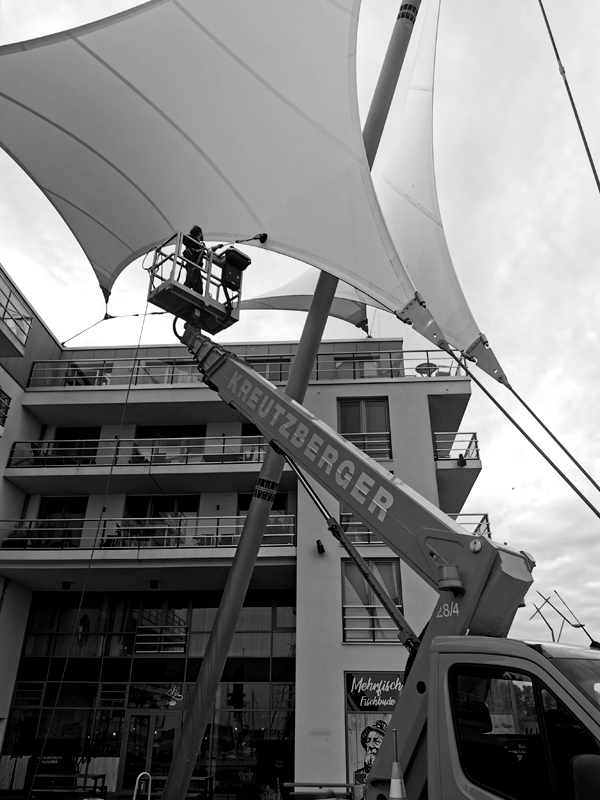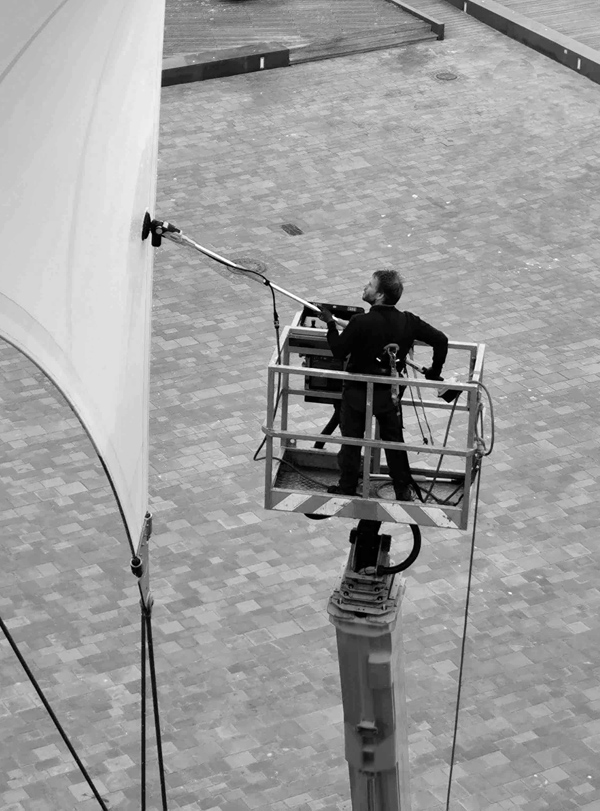The advantages of membrane construction
3dtex GmbH is a leading company for membrane construction. We design and build architectural projects with membranes worldwide. In our view, membranes are a key to innovative and modern architecture, as they offer optimized solutions in many applications, contrasting classic orthogonal building designs.




In general, membrane construction or textile architecture refers to the construction with tensile elements, i.e., slender membranes spanning large areas and transferring their tensile forces onto a substructure. This construction method can be found in the oldest dwellings of mankind in the form of tents or yurts. Today, membranes offer endless possibilities for pioneering and innovative architecture. The most important elements of the structural membrane correspond to the principles of lightweight construction and are therefore optimized for raw materials and structure. Masts, girders, arches, as well as cables and cable nets play an essential role when building membrane substructures.
Membrane structures and other curved surface structures carry loads efficiently and can therefore be designed to have a very shallow effective depth. The tensile forces are carried by tensile elements such as ropes or tension rods, the compression by corresponding elements such as masts, arches, etc. By avoiding bending moments at the bearings of the supporting structure, large cross-sections and massive foundations can be avoided. Therefore, this construction method can be used to cover large open spaces with an extremely light structure.
Thus, membrane construction offers high flexibility for temporary, mobile, and convertible structures. Weight- and mass-optimized designs can facilitate transportation and handling during assembly. In the case of convertible or deployable structures, mobile elements can be easily repositioned (i.e., convertible roofs).
Another advantage of this construction method is that translucent membranes or transparent foils can be used to generate a high amount of light in the building. This enables the use of daylight on a large scale and optimises the use of energy for lighting. For certain buildings, the particularly high yield from solar thermal radiation is also significant. This effect can be advantageous, e.g., in tropical greenhouses or swimming pools.
While there are only right angles in classical architecture, membranes can be used to create exciting shapes, where each shape corresponds with the structural load transfer within the membrane. It is therefore like our specialty to create light and organic spaces, to set accents of color and to build individual solutions. As a general planner for membrane construction, we offer our services in all areas of architecture and look forward to new projects that we implement around the world.
Areas of Application for Textile Buildings
Buildings that use tensile textiles or foils are now widespread. There are different classification systems. In principle, they can be used as a light, open canopy or as a closed façade. Examples of the former are: stage and grandstand roofs, stadium roofs or generally roofs for various sports, places of assembly, etc. Above all, the ability of textile architecture to span large distances without supporting columns plays a decisive role.
However, foils and textiles can also be used to create building envelopes for internal spaces. Areas of application are diverse, from shopping malls to swimming pools or courtyard roofing in the form of an atrium. Semi-tempered rooms are often created in the process, which serve the overall project in terms of building physics. For example, the use of textiles as curtain walls for shading, but also as an architectural design element, is becoming increasingly significant.
3dtex also developed the multi-layer fabric system 3d-IsoSkin, which achieves a U-value of 0.5 W/m²K and is still translucent to allow daylight to pass through. This extends the use of the stretched textiles to fully heated rooms, e.g., in sports or assembly venues.
History and development of membrane construction
Building with textiles or membranes has a long tradition. It is widely known that some of the earliest dwellings consisted of tents or yurts. Many people are not aware that this traditional construction method only regained importance in the 1950s. The image of a dynamic, lightweight construction, as implemented in modern buildings, has long since arrived in the field of architecture and is enjoying increasing enthusiasm.
We would like to share the knowledge about the development of this exciting construction technique and explain the most important stages in the history of modern membrane architecture. The basic principles of membrane architecture are based on a building or structure that uses a membrane as a building envelope and cables and masts to shape it into a spatial form. This construction contrasts solid construction with stone or concrete, which is based on vertical or horizontal load transfer. Membrane structures on the other hand are load-bearing structures functioning only through the creation of curved membrane surfaces. Due to their doubly curved shape, membranes optimally transfer loads such as rain, wind, and snow to the supports.
Materials in membrane construction
In the course of our design assignments for membrane constructions, we advise architects and builders on the required membrane specifications. We strive to keep up-to-date at all times and receive current information about all relevant products on the market from our suppliers. We decide which material is suitable for the respective construction project based on the material properties. Membranes for textile roofing or membrane structures require special material qualifications. Coatings made of PVC/PES, PTFE or silicone are used, which are applied to different types of fabrics such as glass fibre or polyester. A distinction is made between sealed, water-impermeable fabrics and nets or mesh fabrics.
Traditionally, membrane materials are either sewn or welded and, in some cases, glued with a special glue. Important indications of the membrane materials include their fire resistance, susceptibility to buckling, light transmission, and tensile strength. Here are some of the most important textiles in membrane construction:
PVC-Coated Polyester Fabrics
By far the most widely used fabric in textile architecture is PVC polyester fabric. Cost-effective manufacturing processes and good mechanical properties as well as a robust surface allow it to be used for both permanent and temporary membrane constructions. The PVC-coated fabric (polyvinyl chloride polyester, PVC-PES) is insensitive to sunlight, water, or chemical influences. In addition, high-quality PVC-PES fabric is usually available at least in fire protection class B1 /B-s2,d0, flame retardant, which is why it is suitable for a wide range of applications. In addition, easy processing by high frequency welding is possible. PVC-PES fabrics usually have dirt-repellent and antifungal coatings that allow long-term use as a roofing membrane. The service life of PVC-PES fabrics ranges from 20 to over 30 years, depending on the place of use and type of construction.
3dtex GmbH cooperates with the leading manufacturers of PVC-PES fabrics for textile architecture and only uses PVC membranes from European manufacturers.
> more about PVC-coated Fabrics
PTFE Glass Fabric
PFTE glass fabric is characterized by high translucency and is suitable for durable, challenging structures. A PTFE (polytetrafluoroethylene) coating is applied to a fiberglass fabric.
Some versions of PTFE-coated fabric are available in fire protection class A1/ B-s1, d0 (non-combustible), others in B2/ B-s1,d0 (flame retardant). Thanks to their coating, PTFE glass fabrics are highly dirt-repellent, which enables permanently white structures. The service life is at least 30 years with proper design, processing, and installation
ETFE (Ethylene Tetrafluoroethylene) Foils
ETFE foils have exceptional properties that make them particularly suitable for use in lightweight, transparent constructions. ETFE foils are permanently chemically stable, completely UV-resistant, and have sound strength properties. These qualities do not change over time, as ETFE foils do not contain any plasticizers that could evaporate.
Their surface is naturally dirt-repellent, i.e., without additional coatings – the dirt is simply rinsed off with the next rain shower. This gives ETFE a clear advantage over glass. The dead weight of the ETFE foil is also significantly lower than that of glass, which leads to a reduction in mass for the supporting structure, especially where long spans are involved. This has clear economic, but also ecological and aesthetic advantages.
ETFE foils are often designed as multi-layer cushions. This has the advantage that the necessary prestress, which stabilizes the foils against wind and snow loads, can be created simply by applying an internal air pressure. It also makes it possible to create multi-layered cushions to enhance the thermal insulation of a façade construction. Three- or even four-layer cushions are no longer uncommon and achieve U-values of 1.5 W/m²K with a high potential for solar heat gains.
Various prints and colourings allow solar gain to be limited where required on a project-by-project basis. There are also various cushion constructions in which the light admission can be actively controlled. This allows the user to react to different weather conditions as well as different user needs. Such variable cushions can contribute to an adaptive building skin. 3dtex will be happy to advise you on these innovative topics. In general, with the help of several possible adjustments, the most suitable arrangement of ETFE cushions can be developed for each project.
A special application of ETFE are large cushions reinforced by cable nets. This construction method allows enormous spans without a hierarchical substructure. The ETFE foil is reinforced by a cable net which consists of stainless-steel cables spaced approximately 1m apart. This allows minimalist structures to be created with maximum translucency and breathtaking lightness. See our project “Oxigeno” in Costa Rica – currently the largest ETFE cushion in the world with a span of 45m.
The pure material of ETFE without additional coatings is generally recyclable. It does not contain any plasticizers that evaporate over its lifetime. It is flame retardant (B1) and does not create burning drip off in case of fire.
> more about ETFE-Foils
Silicone Glass Fabric
This is a glass fabric coated with silicone, which, just like PTFE, can be produced to be very translucent. Silicone glass fabric is UV-resistant, achieves a long service life and is flame retardant of fire protection class B1/B-s1, d0. The conventionally more adhesive and statically charged surface of silicone is constantly being developed further for architectural fabrics, so that the material is now comparable with conventional architectural membranes in terms of cleaning.
Frequently asked questions about membrane construction
Membrane construction is a very complex planning area that is often used for special buildings and experimental projects. For us, every project is unique and we combine functionality, aesthetics and technology in every detail. We use the specific properties of textiles and other building materials and use them specifically in lightweight construction. The most important questions about membrane construction can be found answered here in a short list.
During the manufacturing and production process, we are in constant communication with our partner companies and use the latest technologies from industry and business. In our work as architects for membrane construction and textile architecture, we are always looking for new and creative ways; there is innovation and research in every design. Special approaches are often required for the realization and assembly of projects. Using digital form-finding programs, we generate the optimal shape in the 3D model and coordinate this with our structural engineers. However, physical models are often used to illustrate the interaction of certain elements. For us, assembly work is part of it: the experience on the construction site contributes significantly to the success of the planning. Through practical work with the membrane, we continually gather valuable insights that we can use for further projects. Maintenance work is also part of our service and is carried out regularly by our team. 3dtex GmbH is a company that implements all products related to textile and membrane architecture.
FAQ
How are membrane structures and textile architecture implemented by 3dtex?
As a general contractor for membrane construction and textile architecture, we plan, manufacture, and build your membrane project. After a preliminary design phase, in which we analyse the special needs of the site and the users, we develop an individually optimal solution together with the architect. For the detailed planning and design, the project is then developed in a 3D model with high precision, structurally analysed and dimensioned. Only after the planning process has been fully completed, the production of the individual parts begins in cooperation with our long-standing partner companies. As a result, 3dtex can offer a high degree of quality and cost certainty. Furthermore, we are a dynamic team and adapt quickly to new challenges. This is how 3dtex GmbH has achieved a particularly broad portfolio of projects. We also create special membrane structures or textile art objects. Do not hesitate, whether you are a client, architect, or planning office: We will be happy to inform and advise you on your construction project.
Which typical membrane materials are used at 3dtex?
Based on many years of cooperation, 3dtex GmbH is in contact with the leading suppliers of membranes and ETFE foils. We are not tied to specific fabric manufacturers, but select the best material for the specific design task on a project-by-project basis. Solid PVC fabric is used regularly. It is versatile, hard-wearing and inexpensive to produce. For high-quality and particularly demanding buildings, PTFE-coated glass fabric or silicone-coated fabric is used. A special feature of coated glass fibre fabrics is their high translucency. For air-supported cushions, transparent ETFE foils are ideal.
Who istalls membrane structures professionally?
At 3dtex, everything comes from a single source – we plan and assemble the structures with permanent employees. This allows valuable experience from the construction site to flow back into planning – a process that has been improving the quality of our structures for years. For very large projects, we call in our extended team of fitters, mostly trained industrial climbers. However, the installation management is always carried out by a specialist from 3dtex.
Do you need fitters for a membrane construction? Feel free to contact us for a quote.
Wer montiert (einfach hier klicken und schreiben) Membranbauten fachgerecht?
At 3dtex, everything comes from a single source – we plan and assemble the structures with permanent employees. This allows valuable experience from the construction site to flow back into planning – a process that has been improving the quality of our structures for years. For very large projects, we call in our extended team of fitters, mostly trained industrial climbers. However, the installation management is always carried out by a specialist from 3dtex. Do you need fitters for a membrane construction? Feel free to contact us for a quote.
Care and Maintenance for textile architecture?
Like any object, a building made of textiles or foils should be cleaned at regular intervals and, if necessary, maintained. The amount of necessary maintenance is usually small, but can vary significantly for different projects. We at 3dtex can inform you as early as in the design phase which maintenance intervals are to be scheduled and provide you with appropriate offers for cleaning and maintenance. This gives you and your client planning security.
Can membrane material also be pronted?
Many membrane manufacturers offer printing on membranes. There are processes on the market today which enable long-lasting and non-fading inks. Please contact us for detailed advice.
How long does it take to design and manufacture an membrane project?
The design time for a membrane construction depends on the complexity of the project. A small sail on a “greenfield” site requires little planning effort and coordination and is therefore implemented much faster than a construction project that has to be integrated into a larger context, such as roofs or façades. The earlier we are involved in a construction project as a specialist planner for membrane construction, the smoother the planning can be. Important time factors are always the approval times of, e.g., building permits or coordination with a structural engineer. If you have any questions about a time frame for your construction project, please contact us.
How much does a membrane roof cost?
The cost of a membrane construction can vary significantly due to the large range of construction methods and materials used. At 3dtex, we usually recommend a preliminary design phase that allows us to determine the basic geometry as well as the most suitable materials. Good planning not only enables an aesthetically pleasing solution, but also the most economically sensible option can be found. As soon as the geometry and materials have been defined, we can provide you with a binding fixed price offer.
Can I request a membrane design from 3dtex?
Yes, as specialist planners for textile architecture, we speak the language of architects and clients, as well as structural engineers. We accompany your project from the initial idea to the installation and work together in various phases with our long-standing partners and experts in the field of membrane architecture. Whether for cost calculation, dimensioning the main load-bearing members, or determining the support loads – the structural design of the membrane provides clarity and forms the basis for safe construction.
Membrane manufacturers and partners
Serge Ferrari group – Mehler Texnologies GmbH – FLONTEX GmbH – NOWOFOL Kunststoffprodukte GmbH & Co. KG – Sioen Industries NV

